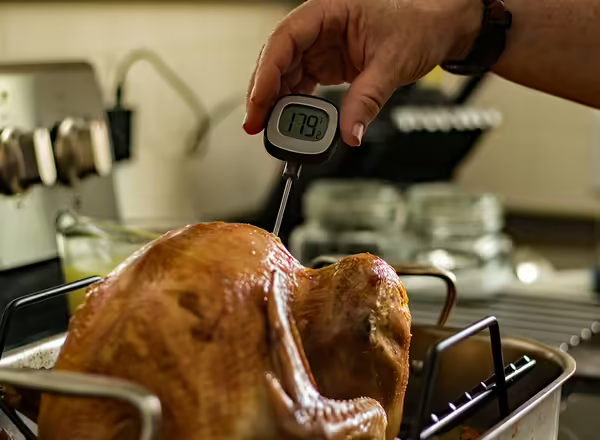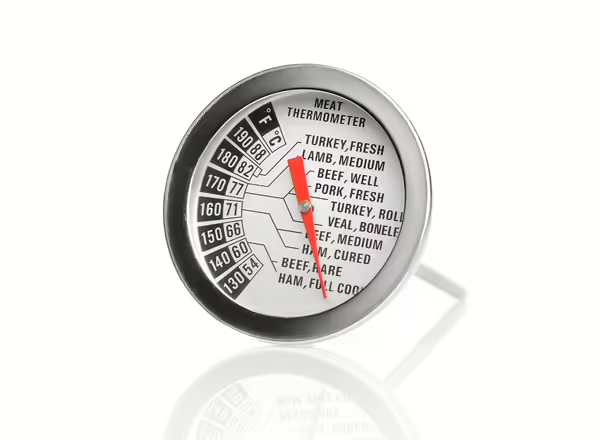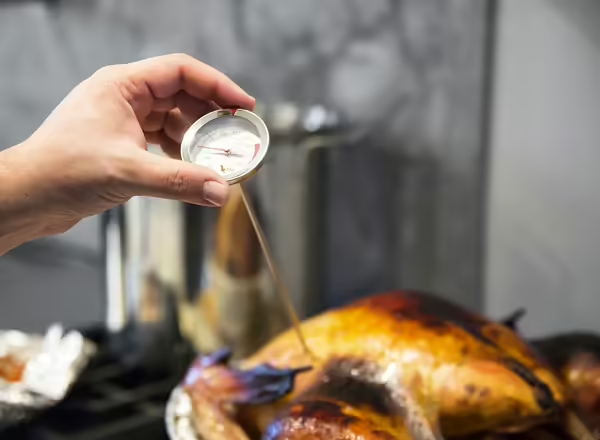
Using a Meat Thermometer
Meat thermometers can be found in the housewares section of most grocery stores, in department stores and in specialty stores. Buy a thermometer, it is a sound investment in food safety.
An instant read thermometer can be digital or dial gauge and it comes in a storage case. Read the information on the package. Instant read thermometers have plastic heads and cannot go into the oven while the turkey is cooking. However, it will register the temperature of food within 15 seconds when the metal tip is inserted up to the dimple on the stem, thus the name "instant read." Always clean the tip before returning it to the case.
Standard meat thermometers are metal and designed to withstand oven temperatures. The sensing area is from the tip to a half-inch past the dimple. This area registers the temperature of the food. Examine the thermometer and familiarize yourself with the dial setting.

-
Positioning the thermometer in the turkey is not difficult. Always place the thermometer in the thickest part of the thigh because the dark meat of turkey thigh takes longer to cook than any other part.
-
Place the thermometer tip in the thick part of the thigh away from the bone. The thigh area closest to the body of the turkey is the thickest part. While you are washing the untrussed turkey, look for a spot to position the thermometer.
-
If using an oven-proof food thermometer, place it in the turkey at the start of the cooking cycle. It will allow you to check the internal temperature of the turkey while it is cooking.
Gently spin the head or dial of the meat thermometer around so you can easily see the reading without removing the turkey from the oven. As the turkey roasts, the thermometer may move out of position, don't worry, and simply reposition the thermometer. A whole turkeys and turkey parts are safe when cooked to a minimum internal temperature of 165 °F as measured with a food thermometer. Check the internal temperature in the innermost part of the thigh and wing and the thickest part of the breast. The turkey is safe to eat at this point but some consumers, for reasons of persona preference, may choose to cook turkey to higher temperatures.

Oven thermometers read the temperature of the air inside of the oven. They are also useful for monitoring the temperature under the lid of a grill. If the oven thermometer registers a higher or lower temperature than the setting, adjust the oven temperature. Check the accuracy of the thermometer (especially an old one) by placing it in a large cup of 50/50 ice and water slush for 10 minutes. It should read 32°F. Thermometers are considered accurate if they are within two degrees on the plus or minus side.
-
To correct the temperature on your instant-read thermometer: with the stem still in the 50/50 water and crushed ice slurry, use a small wrench to turn the calibration nut until the thermometer reads 32°F. For a digital thermometer, simply use the calibration button or change the battery. If your traditional meat thermometer does not have a calibration nut, toss it and invest in a new one.

If using an oven-proof food thermometer, place it in the turkey at the start of the cooking cycle. It will allow you to check the internal temperature of the turkey while it is cooking. For turkey breasts, place thermometer in the thickest part. For whole turkeys, place in the thickest part of the inner thigh. Once the thigh has reached 165 °F, check the wing and the thickest part of the breast to ensure the turkey has reached a safe minimum internal temperature of 165 °F throughout the product.
If your turkey has a "pop-up" temperature indicator, it is recommended that you also check the internal temperature of the turkey in the innermost part of the thigh and wing and the thickest part of the breast with a food thermometer. The minimum internal temperature should reach 165 °F or higher for safety.